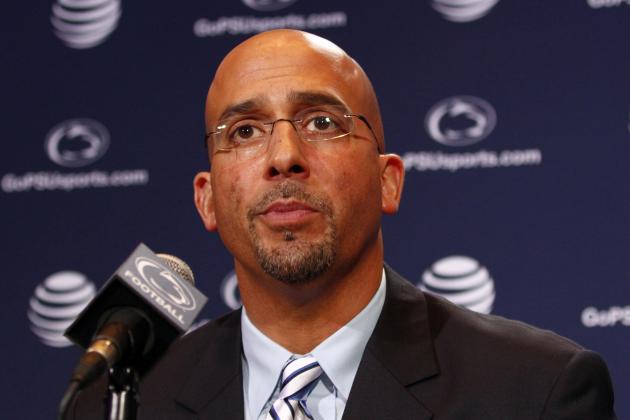Many people felt — and feel, and always will feel — that the NCAA took it easy on Penn State, and that the lifting of a bowl ban early in the 2014 season gave the program a rather soft landing after the events of the previous few years.
You can argue whether the NCAA had to do what it did, and you can argue a million other aspects of the NCAA’s confrontation with Penn State, and how well each side comported itself over multiple years of bitter clashes following the awful and ugly Jerry Sandusky story and everything that accompanied it.
This article is not about any of that.
What should be noted, though, is that while millions of Americans were caught up in the argument about Penn State, and how fairly the program was or wasn’t punished, something else happened: The Nittany Lions were placed in the same Big Ten division as Ohio State, Michigan State, and Michigan.
The placement wouldn’t have seemed nearly as important five years ago, before Michigan State began to hit its stride as a program under Mark Dantonio. The situation wouldn’t have appeared nearly as ominous before Jim Harbaugh came to Ann Arbor to coach his alma mater. Even when Ohio State was coached by Jim Tressel, the Buckeyes were generally not a nuclear superpower in college football. They were “merely” a strong regional power that was not about to allow its borders to be infiltrated. Now, however, Urban Meyer has given Ohio State new dimensions of might and muscularity. If Beano Cook was still among us, he might have said something to the effect that Meyer has turned the Buckeyes from 1970s China into modern China — a lot more sleek, mobile, and potentially devastating.
What was the college football world of 2010 has changed a great deal in the subsequent five years, the years in which Penn State has gone from being “the model program under the model coach,” Joe Paterno, into a dark (but not exceptional) example of what happens when power and money are valued over integrity. It’s not as though this dynamic doesn’t exist at DOZENS of other programs across the country — it most certainly does — but Penn State happened to:
A) manifest those tendencies;
B) provide a supremely ugly example of how terrible the effects can be when said tendencies are in fact revealed for all to see.
After five years of unfathomable change — at Penn State, and throughout the Big Ten — the Nittany Lions no longer have to contemplate a world in which bowl bans and the very survival of the program are in question. Those worries have blessedly drifted into the rearview mirror and are being left behind.
Now, as the school moves forward under a new athletic director (Sandy Barbour) and head football coach (James Franklin), everything is beginning again in University Park, Pa. Even though Franklin took over the program last season, this year feels like a “second first season” for the former Vanderbilt coach. Franklin has recruited up a storm, as he’s always done in his career, and so while the focus unavoidably shifts to his gameday coaching ability — this is where Franklin must prove himself against the Meyer-Dantonio-Harbaugh trio — the 2015 season is situated in a very uncomfortable in-between context for Penn State.
On one hand, given all the turmoil and turnover within Penn State’s walls over the past few years, it doesn’t seem reasonable to expect a 2015 season in which the Nittany Lions smoothly put pieces together and figure out everything about their roster. There are too many moving parts in place, and there were too many flaws on last year’s roster, to expect a quick and dramatic resurgence, to the point where Penn State makes a run at 10 wins.
However, here’s the hard part for Franklin in the Big Ten’s much more cutthroat East Division (compared to the West): If he can’t make some magic this year, will he be able to recruit on par with what Ohio State and Michigan State are doing, and with what Michigan is expected to do under Harbaugh in the course of time?
It’s true that Franklin is a gifted recruiter in a fertile recruiting area of the country. That said, programs need seasons that will capture the attention of new recruits, and if Michigan wins the race with Penn State in the attempt to become a program on par with the Buckeyes and Spartans, the Nittany Lions could get left behind. Penn State and Franklin could become the fourth-best team in the Big Ten East, and potentially stay there for a long time.
Penn State has to be patient… and yet this season — should it end with even a modestly successful 8-4 record through 12 games — might not be enough to keep pace with what Harbaugh will develop in Ann Arbor.
Penn State, as a school and as a program, is far more comfortable and at peace with itself compared to the past four tumultuous years. Yet, the outlook for Nittany Lion football is defined by discomfort to a considerable degree nonetheless.
Even though this program has escaped the biggest worries and fears imaginable, the simpler worries connected to the mere ability to compete in the Big Ten are still as large as Mount Everest.
If James Franklin does succeed at Penn State, it will occur in the face of formidable odds.
